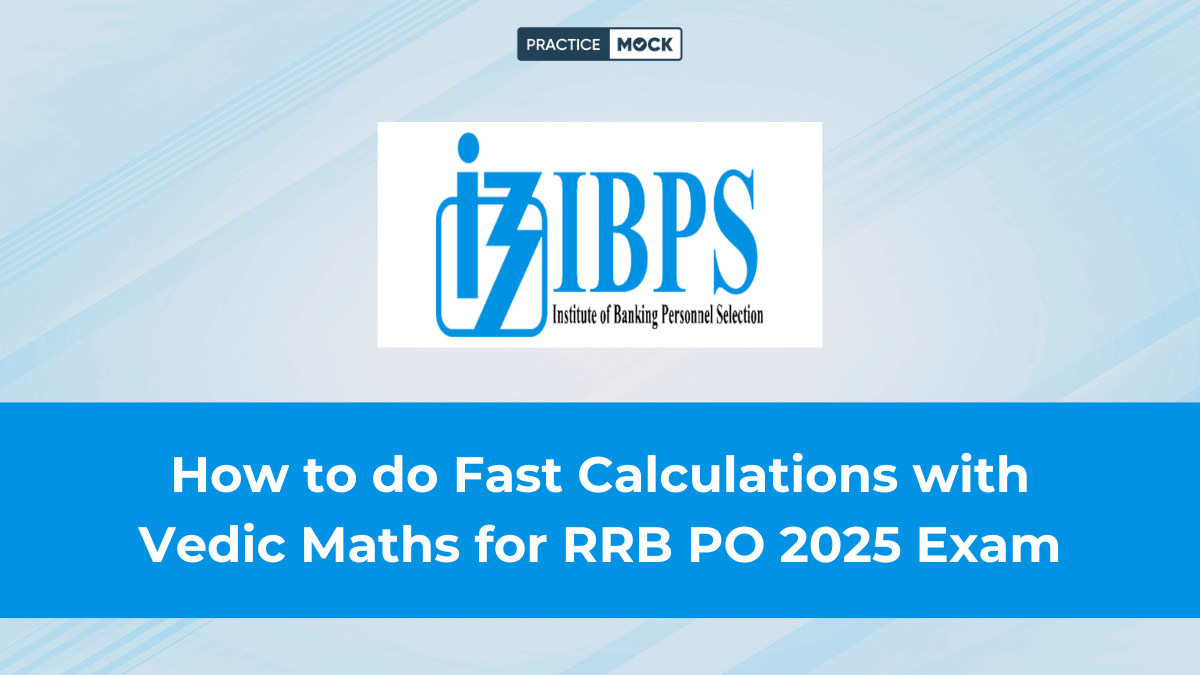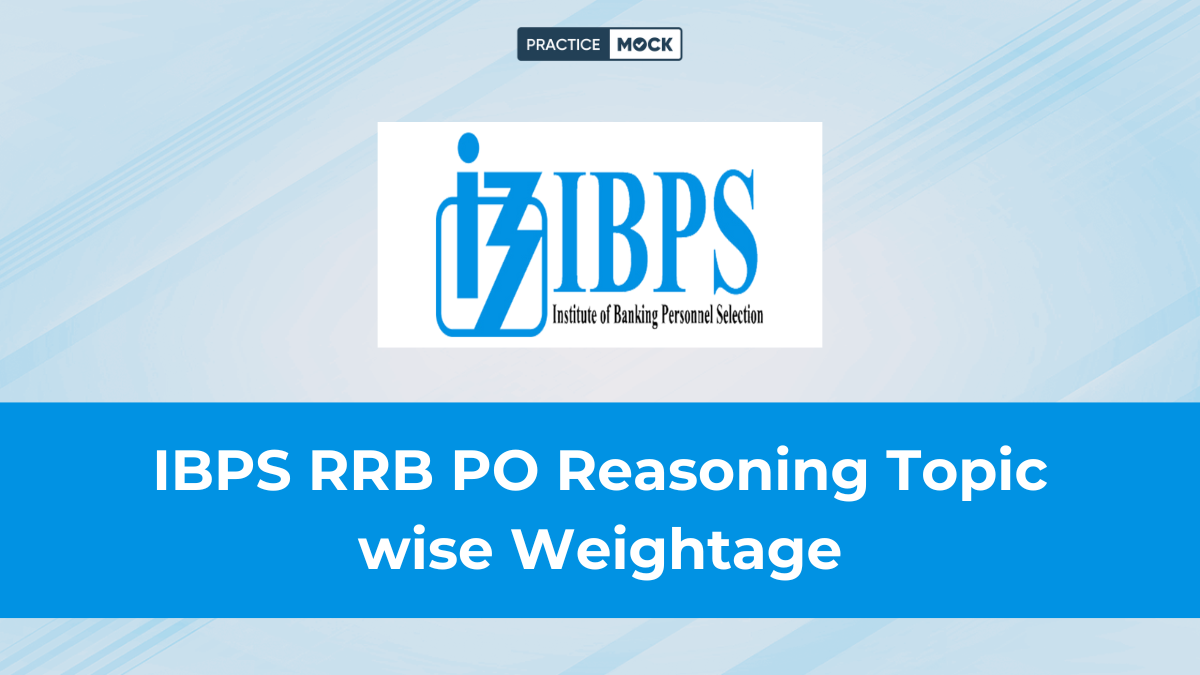How to Solve Number Series Quickly in IBPS RRB PO 2025 Exam?


Number series questions are an important topic in the Quantitative Aptitude section of the IBPS RRB PO 2025 exam. These questions test your ability to identify patterns in a sequence of numbers and predict the next term or identify a missing term. Solving them quickly and accurately can increase your score significantly. This article provides a step-by-step guide to master number series questions, along with practical tips and techniques for the IBPS RRB PO exam
Free Resources for Preparation
- Free Topic Tests and Mini mock Tests: candidates can start preparation with our free mock test, Topic Tests, Free Mini mock Test, Free Previous Year paper and many more study resources
- Previous Papers: Solve past IBPS RRB PO papers to understand the difficulty level and common patterns.
- Telegram & YouTube Channels: Follow the channels telegram https://t.me/bankgovtjobexamprep and PracticeMock YouTube Channel for video tutorials on number series tricks and all the latest details.
| Topics | RRB PO Preparation Resources |
| Free Full-Length Mock Test | RRB PO Free Full-Length Mock Test |
| Reasoning Free topics tests | RRB PO Reasoning Free Topic Test |
| Quant Free Topic Tests | RRB PO Quant Free Topic Test |
Understanding Number Series Questions
Number series questions are a sequence of numbers that follow a specific pattern or rule. Your task is to identify this pattern and find either the next number, a missing number or the wrong number in the series. These questions generally appear in both the preliminary and main stages of the IBPS RRB PO exam, with 5-7 questions in the quantitative aptitude section.
The patterns may be based on arithmetic, geometric or other mathematical operations, such as:
- Arithmetic progressions (for example, adding or subtracting a constant)
- Geometric progressions (for example, multiplying or dividing by a constant)
- Square, cube or factorial-based sequences
- Mixed patterns combining multiple operations
Types Of Number Series
Here we outline the types of number series. Candidates can check the different types of number series and their details in the section below.
Addition/Subtraction Series
This type of number series follows a sequence where the next term is obtained by adding or subtracting some value from the previous term. These subtracted values form a pattern, which the candidate needs to identify.
Multiplication Series
These series follow a sequence in which the next term is obtained by multiplying a number or a series of numbers by the previous term, which may follow patterns involving fixed multipliers, alternating terms or even square and cube roots.
Division Series
These series follow a sequence in which the next term is obtained by dividing the previous term according to a particular rule. The division follows a consistent pattern that needs to be identified to find the next number in the series.
Wrong Number Series
The questions in these types of series appear to be simple, but are complex to find the pattern. You have to figure out which one is the odd one out.
Step-by-step approach to solve the Number Series Questions
1. Look at the sequence carefully
Analyse the given numbers carefully to identify any obvious patterns. Look for differences between consecutive terms or check if the numbers resemble squares, cubes or other familiar sequences.
2. Calculate the difference between positions
Calculate the difference between consecutive numbers to check for patterns in a number series. If the first-level differences are not constant, calculate the second-level difference (difference of differences). This often reveals patterns in more complex series
3. Check for multiplication or division patterns
If the differences do not yield a clear pattern, check if each term is obtained by multiplying or dividing the previous term by a constant
4. Look for Squares, Cubes, or Other Powers
Multiple series are based on squares (n²), cubes (n³), or other powers. Check if the numbers match known sequences like 1, 4, 9, 16 (squares) or 1, 8, 27, 64 (cubes).
- Example: Series: 1, 4, 9, 16, 25
- These are squares of 1, 2, 3, 4, 5. The next term is 6² = 36.
5. Identify Mixed Patterns
Some series combine multiple operations, such as adding a constant and then multiplying, or alternating between two patterns.
6. Practice Common Patterns
- Familiarise yourself with frequently tested patterns in IBPS exams:
- Arithmetic series: Constant difference (e.g., 3, 7, 11, 15; difference = 4)
- Geometric series: Constant ratio (e.g., 3, 9, 27; ratio = 3)
- Square-based: 1, 4, 9, 16 or variations like n² + 1
- Cube-based: 1, 8, 27, 64
7. Solve Previous Year Papers
After knowing all the strategies, candidates must solve past 5 to 6 years’ question papers and know the types of number series questions asked in the examination. Candidates solve multiple types of questions so that they can boost their speed at solving Number series questions.
8. Take the Number series Topic Test
We are providing the Number series topic-wise tests. Take Number Series topic tests to strengthen your pattern recognition and increase accuracy in solving number series questions. Regular practice helps you quickly identify common patterns such as arithmetic, geometric or square/cube series. This topic test is time-bound and improves your speed and gets you exam-ready
Important Questions For IBPS RRB PO Number Series
Here we are providing some practice questions to boost your question-solving speed. This question is provided in PDF format with a detailed solution.
Directions: Answer the questions based on the information given below:
Seven boxes A, B, C, D, E, F and G are kept one above another such that the bottommost box is numbered as 1 while the topmost as 7. Each of the boxes is of different colours among Black, Blue, Green, Pink, Red, White and Yellow.
Box D is just above the black box. Box E is the even numbered box. Box F is two boxes below the White box. Box E is just above the White box. Pink box is just above Blue box. Box G is of Black colour. Neither box E nor F is of yellow colour. There are two boxes between box D and box A. The topmost box is of Green colour. Box F is not of Blue colour. Box B is above box C, which is above box G. Box D is not the red box. Yellow box is not adjacent to box B.
Common solution:
Now, box E is the even numbered box. Box F is two boxes below the White box. Box E is just above the White box. The topmost box is of Green colour. So, we have,
Case 1:
| Box number | Boxes | Colours |
| 7 | Green | |
| 6 | E | |
| 5 | White | |
| 4 | ||
| 3 | F | |
| 2 | ||
| 1 |
Case 2:
| Box number | Boxes | Colours |
| 7 | Green | |
| 6 | ||
| 5 | ||
| 4 | E | |
| 3 | White | |
| 2 | ||
| 1 | F |
Now, Box G is of Black colour. Box D is just above the black box. Neither box E nor F is of black colour. There are two boxes between box D and box A. Box F is not of Blue colour.
Case 1:
| Box number | Boxes | Colours |
| 7 | Green | |
| 6 | E | |
| 5 | A | White |
| 4 | ||
| 3 | F | Pink |
| 2 | D | Blue |
| 1 | Black |
Case 2:
| Box number | Boxes | Colours |
| 7 | Green | |
| 6 | D | |
| 5 | Black | |
| 4 | E | |
| 3 | A | White |
| 2 | Pink | |
| 1 | F | Blue |
Now, Box B is above box C, which is above box G. Yellow box is not adjacent to box B. Box D is not the red box. So, we have,
| Box number | Boxes | Colours |
| 7 | B | Green |
| 6 | E | Red |
| 5 | A | White |
| 4 | C | Yellow |
| 3 | F | Pink |
| 2 | D | Blue |
| 1 | G | Black |
Question 1: How many boxes are above box F?
A) Three
B) Two
C) Four
D) Five
E) None of these
Solution 1: 3)
Four boxes are above box F.
Hence, option c.
Question 2: What is the colour of box D?
A) Green
B) Pink
C) Yellow
D) Blue
E) None of these
Solution 2: 4)
Box D is of blue colour.
Hence, option d.
Question 3: Which box is of Red colour?
A) D
B) G
C) B
D) E
E) None of these
Solution 3: 4)
Box E is of red colour.
Hence, option d.
Question 4: Which box is three boxes above box D?
A) E
B) A
C) F
D) G
E) None of these
Solution 4: 2)
Box A is three boxes above box D.
Hence, option b.
Question 5: Which box is just above the Red box?
A) White box
B) Blue box
C) Pink box
D) Green box
E) None of these
Solution 5: 4)
Green box is just above Red box.
Hence, option d.
Related Blogs
For More Details Regarding the IBPS RRB PO 2025 Notification, candidates can click on the provided links. Important details of the IBPS RRB PO and Clerk, such as syllabus, exam pattern, cut-off, online application, and previous year papers, are provided.
IBPS RRB PO Other Article
| IBPS RRB PO Salary | IBPS RRB PO Exam Pattern |
| IBPS RRB PO Cut Off | IBPS RRB PO Syllabus |
| IBPS RRB PO Previous Year Question Papers |
Join our exclusive Telegram group where our experts are ready to answer all your queries, guide you in banking exam preparation, and give personalised tips to boost your success. Get access to real-time solutions, expert advice, and valuable resources to improve your study journey. [Click here to join now!]
Recent Posts
500 Most Repetitive One-word Substitutions for SSC CGL 2025
In this blog, we have provided the 500 Most Repetitive One-word Substitutions for SSC CGL…
IBPS RRB Notification 2025, PO & Clerk Exam Date Out, Check All Upcoming Events
The IBPS RRB Notification 2025 is expected to be released in June 2025. candidates can…
How to do Fast Calculations with Vedic Maths for RRB PO 2025 Exam
In this article we are providing the preparation Strategy to do Fast Calculations with Vedic…
Top 5 Puzzles to Practice for RRB PO 2025 Exam, Check Strategies to Solve Question
Here we are providing the Top 5 Puzzles to Practice for the RRB PO 2025…
Most Asked Compound Interest Questions for RRB Clerk 2025 Exam
In this article we have shared the most asked compound interest questions for the RRB…
SSC CGL Question Paper Free PDF Based On Previous Year
This blog has provided the SSC CGL Question Paper Free PDF Based On Previous Year.…



